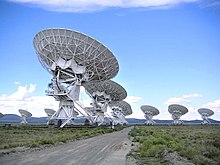Karl G. Jansky Very Large Array
 |
|
| Organisation |
National Radio Astronomy Observatory |
|---|---|
| Location(s) |
Socorro County |
| Coordinates | 34°04′43.497″N 107°37′05.819″W / 34.07874917°N 107.61828306°WCoordinates: 34°04′43.497″N 107°37′05.819″W / 34.07874917°N 107.61828306°W |
| Altitude | 2,124 metres (6,969 ft) |
| Wavelength | radio, 0.6–410 cm (50 GHz–73 MHz) |
| Built | 1973–1980 |
| Telescope style | Interferometer |
| Diameter | 27×25 m |
| Angular resolution | 0.2 to 0.004 arcsec |
| Collecting area | 13,250 m² (f/0.36) |
| Website | www |
|
|
|
|
[]
|
|
The Karl G. Jansky Very Large Array (VLA) is a radio astronomy observatory located on the Plains of San Agustin, between the towns of Magdalena and Datil, some 50 miles (80 km) west of Socorro, New Mexico. It comprises 27 25-meter radio telescopes in a Y-shaped array and all the equipment, instrumentation, and computing power to function as an interferometer. Each of the massive telescopes is mounted on double parallel railroad tracks, so the radius and density of the array can be transformed to adjust the balance between its angular resolution and its surface brightness sensitivity. Astronomers using the VLA have made key observations of black holes and protoplanetary disks around young stars, discovered magnetic filaments and traced complex gas motions at the Milky Way's center, probed the Universe's cosmological parameters, and provided new knowledge about the physical mechanisms that produce radio emission.
The VLA stands at an elevation of 6970 ft (2124 m) above sea level. It is a component of the National Radio Astronomy Observatory (NRAO).
The radio telescope comprises 27 independent antennae, each of which has a dish diameter of 25 meters (82 feet) and weighs 209 metric tons (230 Short tons). The antennae are distributed along the three arms of a track, shaped in a wye (or Y) -configuration, (each of which measures 21 km/13 miles long). Using the rail tracks that follow each of these arms—and that, at one point, intersect with U.S. Route 60 at a level crossing—and a specially designed lifting locomotive ("Hein's Trein"), the antennas can be physically relocated to a number of prepared positions, allowing aperture synthesis interferometry with up to 351 independent baselines: in essence, the array acts as a single antenna with a variable diameter. The angular resolution that can be reached is between 0.2 and 0.004 arcseconds.
...
Wikipedia
